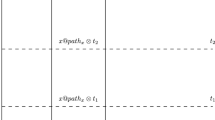Abstract
The eternalist endurantist and perdurantist theories of persistence through time come in various versions, namely the two versions of perdurantism: the worm view and the stage view, and the two versions of endurantism: indexicalism and adverbialism. Using as a starting point the instructive case of what is depicted by photographs, I will examine these four views, and compare them, with some interesting results. Notably, we will see that two traditional enemies—the perdurantist worm view and the endurantist theories—are more like allies: they are much less different than what is usually thought, and some alleged points of central disagreement fall prey to closer scrutiny. The aim of this paper is to examine carefully all those points, and to call attention to the places where the real differences between these views lie. I will then turn to the perdurantist stage view, and claim that with respect to some central issues it is the view that is the most different from the other three, but that in some places the reason why it different is also the reason why it is less satisfactory.
Similar content being viewed by others
Notes
I use "depict" roughly in the sense of what a photograph represents; and I use it neutrally with respect to the debate concerning questions about whether photographs depict something in the same way paintings do.
Compare Lewis (2002) for this and below.
The adverbialist strategy will be discussed in Sect. 2.6 below.
Granted, and close to Lewis' heart, only the perdurantist worm view allows for something (but not Sam) to have temporary intrinsic properties simpliciter, namely, temporal parts of Sam. I will come back to this at the end of Sect. 2.5.
See Van Inwagen (1985).
Given the purposes, the scope, and the length of this paper, I unfortunately cannot examine all possible variants of these two views, and I will limit myself to the general way they work, which will be enough for what I want to claim. I will also ignore in this paper the ‘substance’ theory (for the same reasons as those just given, and because I think it does not work at all, for reasons entirely independent on the debate I am interested in here).
See my Benovsky (2008) for a detailed comparison between the bundle theory and the substratum theory—a place where I argue in favour of an equivalence between (some variants of) these two views.
Laurie Paul in her defence of the bundle theory speaks about "logical parts" here, and defends a genuine property mereology (Paul 2002). In Paul 2006 (especially Sects. 2.2 and 2.3) she develops in detail the idea that ordinary objects are qualitative fusions that have properties as parts, and explores the interesting consequences this has on the problem of coincidence; what I say about the Statue and Lump case below is a simplified version (that is sufficient for my purposes in this paper) of the same basic idea that she discusses brilliantly in more depth.
Indexing the bundling relation would make it straightforwardly a perdurantist view.
In the case of endurantist adverbialism, the substratum theory would be needed, which would not make any relevant difference to my present concerns.
Both Ted Sider and Achille Varzi do accept this consequence of the stage view (personal communications, 2005); see also Sider (2001b).
Besides, it is likely that whatever the temporal counterpart relation is, it twill turn out to be the same as the ‘glue’ relation that unifies the temporal parts of a single space-time worm.
References
Benovsky J (2008) The bundle theory and the substratum theory: deadly enemies or twin brothers? Philos Stud 141:175–190
Haslanger S (2003) Persistence through time. In: Loux M, Zimmerman D (eds) Oxford handbook of metaphysics. Oxford University Press, Oxford
Johnston M (1987) Is there a problem about persistence? Aristot Soc 61:107–135
Lewis D (1983) New work for a theory of universals. Aust J Philos 61:343–377
Lewis D (1986) On the plurality of worlds. Blackwell, Oxford
Lewis D (2002) Tensing the copula. Mind 111:1–13
Mellor DH (1998) Real time II. Routledge, London
Parsons J (2004) Review of ‘four-dimensionalism’ by Theodore sider. Philos Q 54:188–191
Paul L (2002) Logical parts. Noûs 36:578–596
Paul L (2006) Coincidence as overlap. Noûs 40:623–659
Prior A (1996) Some free thinking about time. In: Copeland J (ed) Logic and reality: essays on the legacy of Arthur Prior. Oxford Clarendon Press, Oxford
Sider T (2001a) Four-dimensionalism. Clarendon Press, Oxford
Sider T (2001b) Maximality and intrinsic properties. Philos Phenomenol Res 63:357–364
Sider T (2006) Bare particulars. Philos Perspect 20:387–397
Simons P (2000) How to exist at a time when you have no temporal parts? The Monist 83:419–436
Van Inwagen P (1981) The doctrine of arbitrary undetached parts. Philos Q 62:123–137
Van Inwagen P (1985) Plantinga on trans-world identity. In: Tomberlin J, Van Inwagen P (eds) Alvin plantinga: a profile. Reidel, Dordrecht, pp 101–120
Acknowledgments
For very valuable comments and suggestions, I would like to thank Michael Esfeld, Fabian Dorsch, Mark Heller, Laurie Paul, and Gianfranco Soldati, as well as the participants to the SOPHA Conference in Aix-en-Provence. The photograph included in this paper is protected by international copyright by Jiri Benovsky, www.benovsky.com.
Author information
Authors and Affiliations
Corresponding author
Rights and permissions
About this article
Cite this article
Benovsky, J. Eternalist Theories of Persistence Through Time: Where the Differences Really Lie. Axiomathes 19, 51–71 (2009). https://doi.org/10.1007/s10516-008-9055-y
Received:
Accepted:
Published:
Issue Date:
DOI: https://doi.org/10.1007/s10516-008-9055-y



